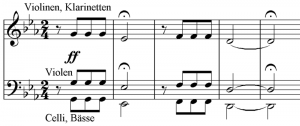The interpretation: the motivic thorough-composition is hearable through a modified piano playing.
December 14, 2008
What is actually the art of the motivic thorough-composition?
Developing a theme is nothing but the quintessence of the composer’s work.
How does it happen?
No matter how often, how slowly, or fast, or even loud or soft the theme is announced, this is a very personal decision of the composer. The motif could even be the emblem, which is representing the entire musical work of the author.
Let’s draw our attention to the striking theme from Beethoven’s fifth symphony:

Score picture: Beethoven Main theme from the Symphony No.5 Op.67- Source: Wikipedia
This is doubtless one of the most important and innovative themes in the music history. Figuring the steady fight of Beethoven against the fate, this famous opening strongly influenced the further development of the traditional sonata form.
According with insiders, the sonata form represents the central point of the art of composition, especially when considering sonatas and symphonies of the 18th, 19th, and 20th century.
This musical form could be compared to a framework, in which the object is constructed and developed, in this case the musical work as the sonata or the symphony.
Let us get back to our motivic thorough-composition.
If we consider this composing technique as the composer’s logo, we could fervently be tempted to ask the question, whether the way to a successful interpretation drives us either to remaining true to the score or true to the masterwork.
In answer to this question we should remind of the issue of this essay.
The motivic thorough-composition is hearable.
To make this happen we need to apply a particular art of piano playing, which goes far beyond the usual technical abilities.
The control of the kinesthetic feeling only represents the fundamental skill to reach the effective technical abilities on the instrument.
To achieve this goal means the comprehension of accurate analysis and synthesis of the composition’s structure.
The interpreter is identifying himself with the composition and his playing is inevitably modified. Let us think again about the symphony, the motivic thorough-composition includes the complete identification with the creative thought of the composer.
So it can be affirmed that symphonic thinking is equal to symphonic feeling, and last means symphonic playing or reproducing.
The motivic development of a musical work is directly related to a symphonic-structrured knowledge: deeply understanding how a theme is developing and evolving through the way of polyphonic manner.
A pianist receives the basic education in polyphony studying J.S.Bach, particularly the Preludes and Fugues from the Well-tempered Clavier.
Further steps in polyphony can be pursued in the 32 piano sonatas by Beethoven.
Continuing the research of mysteries and enigmas of the polyphonic style can guide us to works by Chopin, Brahms and Rachmaninoff. When discovering Prokofieff’s music we can actually meet the union of polyphony and polyrhythm.
As a conclusion we can say that the circle always closes, in life, in the universe, as well as in music. Music is the language of universe, and universe is polyphony.
Once we understand polyphony, we even understand the motivic thorough-composition.
